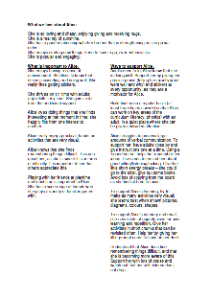 Written by guest blogger Tabitha Smith, then SENCO and Deputy Head at Norris Bank Primary School, Stockport
Written by guest blogger Tabitha Smith, then SENCO and Deputy Head at Norris Bank Primary School, Stockport
I’ve worked in education for over 20 years and 18 of these have been in Stockport. It was whilst teaching at Norris Bank Primary school in 2008 that I was first introduced to one-page profiles. Helen Sanderson is the mother of one of our old pupils and she came into school to talk to us about Laura’s progress. She introduced us to a single sheet of paper which communicated perfectly what people liked and admired about Laura, what was important to her and how best we could support her. This was the beginning of something huge; our personalisation journey.
We immediately saw the value of the one-page profile as a means to improve communication, learn about the individual requirements of each child, celebrate their gifts and talents and therefore teach and support them well.
At first we introduced the profiles to years two and six. We wanted to use them to help pupils in the transition from infant to juniors and from primary up to secondary. We had decided early on that this was not a tool to be used just with the children that had been identified as having ‘special educational needs’ as our belief is that all children have special or individual requirements and that each of them would benefit from using a one-page profile.
The children were incredibly excited about and receptive to creating their profiles. It wasn’t the first time we had asked them to tell us what they needed to work well but it was the first time we had introduced such a positive way of capturing this information, of embedding this culture deep into the roots of our school. We soon realised that we needed to give every child the opportunity to create their own profile and so we made this commitment.
I won’t lie and tell you that it was easy. It wasn’t. We have 340 pupils at Norris Bank and the coordination of communication between pupils, parents and teachers as well as the administration that was required, was enough to cause even the most committed of professionals a few sleepless nights! But we did it. In 2009 we achieved our aim or arming each child with their own one-page profile and setting a system in place that means that each year they re-work their profiles in time for their move to the next class.
We now know what each child needs to be supported well. This could be something as simple as how they like to be encouraged, what type of classroom environment they thrive in or whether there is any equipment the child needs to aid their communication or learning. Our parents are able to share with us the things that they love and admire about their child and we can celebrate this together – bridging the gap between home and school life. We have a point of reference for every parent’s evening and a detailed introduction to new teachers of each and every pupil. And crucially, our pupils feel valued and empowered to tell us what is important to and for them.
This year I accepted a Headship at a new school and I will be taking my learning of one-page profiles and the power of personalisation in education with me but I wanted to share with you five top tips to successfully introduce profiles in your school. I said before that it wasn’t easy – but as we have been through the process, we have learnt what works and what doesn’t work and now have a system that is absolutely achievable for schools – and believe me, the results are well worth the effort!
Using one-page profiles in a school setting:
- Understand their worth: It is important that the people making it happen (the teachers, pupils, parents and admin staff) understand how a one-page profile can benefit a child in school, how it can aid their learning, improve communication, highlight the need for new measures of support and celebrate their gifts and talents. We did this through training sessions, but also having resources like this blog site is a great way to share the ‘power of the one-page profile’!
- Give yourself time: It takes time to achieve a task of this scale and giving yourself an unrealistic time frame will only de-motivate you. Think first about the practicalities of training people about one-page profiles, producing them, involving parents, capturing and storing the information then base your time scale on this.
- Keep it simple: We learnt early on that trying to type up each and every one-page profile and store them electronically wasn’t for us! We now send post cards out to parents at the end of each school year and they add the section about what they like and admire about their child. The children then return the cards to the class room and work through the sections ‘what is important to them and how best to support and encourage them in school’. Pupils personalise their postcard profiles with colours and drawings which further capture their personalities. The cards are then kept in a plastic flip wallet by the teacher and can be taken out and looked at or added to at any time.
- Involve parents: The benefits of a child having a one-page profile far transcends school and involving parents in the process early by getting them to add to the profiles is a good way of introducing them to the tool. We had an army of volunteers helping us when we first rolled out the project and although now we have streamlined it, we don’t need this administrative support, we still involve parents and are able to capture their rich insight into their child.
- Walk the walk: Capturing information isn’t enough. It is how you use it that will make your introduction of one-page profiles in school a success. We adapt our teaching style to our pupils based in what they have told us. We make decisions about their support based on what we know about them. We share this information with parents and with their new secondary school because we believe it is of vital importance. We see each or our pupils as individuals and whilst they may all be taught the same curriculum, we do it in the way that best suits them.


